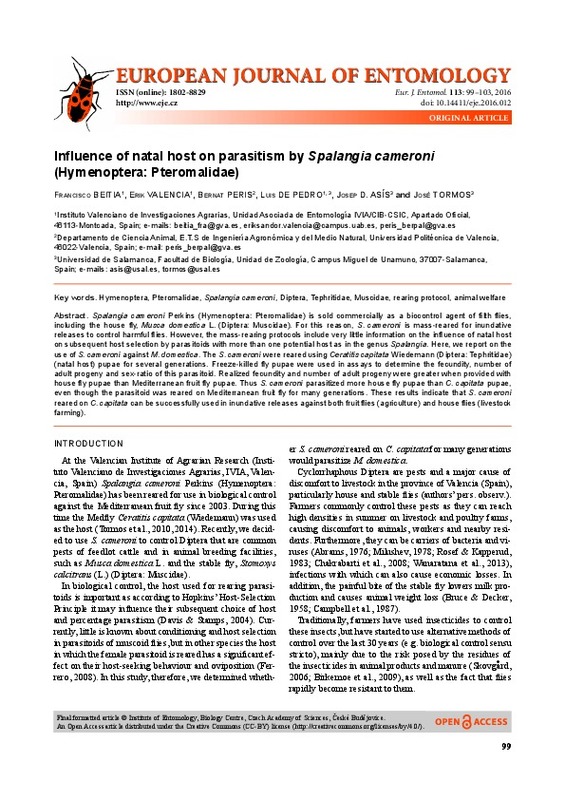Birkemoe, T., Soleng, A., & Aak, A. (2008). Biological control of Musca domestica and Stomoxys calcitrans by mass releases of the parasitoid Spalangia cameroni on two Norwegian pig farms. BioControl, 54(3), 425-436. doi:10.1007/s10526-008-9190-9
Bruce, W. N., & Decker, G. C. (1958). The Relationship of Stable Fly Abundance to Milk Production in Dairy Cattle1. Journal of Economic Entomology, 51(3), 269-274. doi:10.1093/jee/51.3.269
Campbell, J. B., Berry, I. L., Boxler, D. J., Davis, R. L., Clanton, D. C., & Deutscher, G. H. (1987). Effects of Stable Flies (Diptera: Muscidae) on Weight Gain and Feed Efficiency of Feedlot Cattle. Journal of Economic Entomology, 80(1), 117-119. doi:10.1093/jee/80.1.117
[+]
Birkemoe, T., Soleng, A., & Aak, A. (2008). Biological control of Musca domestica and Stomoxys calcitrans by mass releases of the parasitoid Spalangia cameroni on two Norwegian pig farms. BioControl, 54(3), 425-436. doi:10.1007/s10526-008-9190-9
Bruce, W. N., & Decker, G. C. (1958). The Relationship of Stable Fly Abundance to Milk Production in Dairy Cattle1. Journal of Economic Entomology, 51(3), 269-274. doi:10.1093/jee/51.3.269
Campbell, J. B., Berry, I. L., Boxler, D. J., Davis, R. L., Clanton, D. C., & Deutscher, G. H. (1987). Effects of Stable Flies (Diptera: Muscidae) on Weight Gain and Feed Efficiency of Feedlot Cattle. Journal of Economic Entomology, 80(1), 117-119. doi:10.1093/jee/80.1.117
Crespo, D. C., Lecuona, R. E., & Hogsette, J. A. (1998). Biological Control: An Important Component in Integrated Management ofMusca domestica(Diptera: Muscidae) in Caged-Layer Poultry Houses in Buenos Aires, Argentina. Biological Control, 13(1), 16-24. doi:10.1006/bcon.1998.0632
Chakrabarti, S., King, D. J., Cardona, C. J., & Gerry, A. C. (2008). Persistence of Exotic Newcastle Disease Virus (ENDV) in Laboratory Infected Musca domestica and Fannia canicularis. Avian Diseases, 52(3), 375-379. doi:10.1637/8173-111407-reg
DAVIS, J. (2004). The effect of natal experience on habitat preferences. Trends in Ecology & Evolution, 19(8), 411-416. doi:10.1016/j.tree.2004.04.006
Geden, C. J., & Hogsette, J. A. (2006). Suppression of House Flies (Diptera: Muscidae) in Florida Poultry Houses by Sustained Releases ofMuscidifurax raptorellusandSpalangia cameroni(Hymenoptera: Pteromalidae). Environmental Entomology, 35(1), 75-82. doi:10.1603/0046-225x-35.1.75
Geden, C. J., & Kaufman, P. E. (2007). Development of <I>Spalangia cameroni</I> and <I>Muscidifurax raptor</I> (Hymenoptera: Pteromalidae) on Live House Fly (Diptera: Muscidae) Pupae and Pupae Killed by Heat Shock, Irradiation, and Cold. Environmental Entomology, 36(1), 34-39. doi:10.1603/0046-225x(2007)36[34:doscam]2.0.co;2
Geden, C. J., & Moon, R. D. (2009). Host Ranges of Gregarious Muscoid Fly Parasitoids:Muscidifurax raptorellus(Hymenoptera: Pteromalidae),Tachinaephagus zealandicus(Hymenoptera: Encyrtidae), andTrichopria nigra(Hymenoptera: Diapriidae). Environmental Entomology, 38(3), 700-707. doi:10.1603/022.038.0321
Geden, C. J., Smith, L., Long, S. J., & Rutz, D. A. (1992). Rapid Deterioration of Searching Behavior, Host Destruction, and Fecundity of the Parasitoid Muscidifurax raptor (Hymenoptera: Pteromalidae) in Culture. Annals of the Entomological Society of America, 85(2), 179-187. doi:10.1093/aesa/85.2.179
Kaufman, P. E., & Geden, C. J. (2009). Development ofSpalangia cameroniandMuscidifurax raptor(Hymenoptera: Pteromalidae) on Live and Freeze-Killed House Fly (Diptera: Muscidae) Pupae. Florida Entomologist, 92(3), 492-496. doi:10.1653/024.092.0311
Kaufman, P. E., Long, S. J., & Rutz, D. A. (2001). Impact of Exposure Length and Pupal Source on <I>Muscidifurax raptorellus</I> and <I>Nasonia vitripennis</I> (Hymenoptera: Pteromalidae) Parasitism in a New York Poultry Facility. Journal of Economic Entomology, 94(4), 998-1003. doi:10.1603/0022-0493-94.4.998
King, B. H. (2002). Offspring Sex Ratio and Number in Response to Proportion of Host Sizes and Ages in the Parasitoid WaspSpalangia cameroni(Hymenoptera: Pteromalidae). Environmental Entomology, 31(3), 505-508. doi:10.1603/0046-225x-31.3.505
Machtinger, E. T., & Geden, C. J. (2015). Comparison of the Olfactory Preferences of Four of Filth Fly Pupal Parasitoid Species (Hymenoptera: Pteromalidae) for Hosts in Equine and Bovine Manure. Environmental Entomology, 44(5), 1417-1424. doi:10.1093/ee/nvv120
Mandeville, J. D., & Mullens, B. A. (1990). Host Preference and Learning in Muscidifurax zaraptor (Hymenoptera: Pteromalidae). Annals of the Entomological Society of America, 83(6), 1203-1209. doi:10.1093/aesa/83.6.1203
Ogawa, K., Ito, K., Fukuda, T., Tebayashi, S., & Arakawa, R. (2012). Host Suitability of House Fly,Musca domestica(Diptera: Muscidae), Pupae Killed by High or Low Temperature Treatment for a Parastoid,Spalangia endius(Hymenoptera: Pteromalidae). The Scientific World Journal, 2012, 1-4. doi:10.1100/2012/214907
Skovgård, H. (2006). Search Efficiency of Spalangia cameroni and Muscidifurax raptor on Musca domestica Pupae in Dairy Cattle Farms in Denmark. Biocontrol, 51(1), 49-64. doi:10.1007/s10526-005-6759-4
Skovgård, H., & Nachman, G. (2004). Biological control of house flies Musca domestica and stable flies Stomoxys calcitrans (Diptera: Muscidae) by means of inundative releases of Spalangia cameroni (Hymenoptera: Pteromalidae). Bulletin of Entomological Research, 94(6), 555-567. doi:10.1079/ber2004322
Smith, M. A., & Cornell, H. V. (1979). Hopkins host-selection in Nasonia vitripennis and its implications for sympatric speciation. Animal Behaviour, 27, 365-370. doi:10.1016/0003-3472(79)90170-2
Tormos, J., Beitia, F., Böckmann, E. A., & Asís, J. D. (2009). The preimaginal stages and development of Spalangia cameroni Perkins (Hymenoptera: Pteromalidae) on Ceratitis capitata (Wiedemann) (Diptera: Tephritidae). Micron, 40(5-6), 646-658. doi:10.1016/j.micron.2009.02.001
(2010). Annals of Applied Biology, 156(2). doi:10.1111/aab.2010.156.issue-2
Tormos, J., Sabater-Muñoz, B., Asís, J. D., & Beitia, F. (2014). Validation of a methodology for rearingSpalangia cameroni(Hymenoptera: Pteromalidae) onCeratitis capitata(Diptera: Tephritidae). The Canadian Entomologist, 146(6), 676-683. doi:10.4039/tce.2014.15
Wanaratana, S., Amonsin, A., Chaisingh, A., Panyim, S., Sasipreeyajan, J., & Pakpinyo, S. (2013). Experimental Assessment of Houseflies as Vectors in Avian Influenza Subtype H5N1 Transmission in Chickens. Avian Diseases, 57(2), 266-272. doi:10.1637/10347-090412-reg.1
[-]









